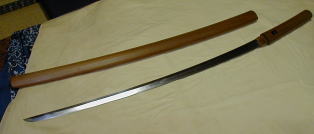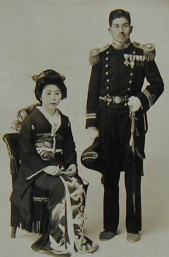 Iwo-jima |
 |
#17 August, 2001 | ||||||
 Iwo-jima |
 |
#17 August, 2001 | ||||||
The Miracle Sword Ѓ\A Wish for PeaceЃ\ Ѓ@Ѓ@Ѓ@Ѓ@Ѓ@Ѓ@Ѓ@Ѓ@Ѓ@Ѓ@Ѓ@Ѓ@Ѓ@Ѓ@Ѓ@Ѓ@Ѓ@Ѓ@Ѓ@Ѓ@Ѓ@Ѓ@Ѓ@Ѓ@Ѓ@Ѓ@Ѓ@Ѓ@Ѓ@Ѓ@Ѓ@ Ѓ@Japanese |
||||||||||
| Dear friends, Do you believe in miracles? I hope that you do because if there are no miracles then there would be no need to make a wish. It would be like a heaven without stars. I have a friend who made wishes from the bottom of her heart and the wishes came true. I will tell you her special story this month because August is a time of remembrance for all people who lost loved ones during World War‡Uin the Pacific. Her name is Haruko Ichimaru. She is the eldest of the three daughters of the late Rinosuke Ichimaru, Vice Admiral ( at the time of his death) of the Japanese Imperial Navy who died on Iwo-jima in 1945.
Rinosuke Ichimaru was born in Karatsu in 1891 and died in 1945, 5 months before the end of the war. His entire life was dedicated to the Japanese Navy as a Navy fighter pilot and later an air commander despite having suffered severe injuries in a plane crash. After the crash it took him many years to recuperate from his injuries and return to active Navy duty. During the dark days of his recuperation he read books, wrote poetry, painted pictures, and turned his reflection inward to discover his true self. He was almost ready to give up hope of resurrecting his Navy career when the Japanese Navy decided to let him establish a flight school for young fighter pilots. Rinosuke Ichimaru was the first Commander of 'Yokaren' where he taught his high school age students not only to be soldiers but also to be gentlemen above all else. His principles of education were most humane. Eventually, even this wounded commander had to return to the battlefield. He was in command of the Navy on Iwo-jima in 1945. The desperate battle of the island of Iwo-jima has become immortalized in the minds of most people by the famous photo of the raising of the Stars and Stripes on top of Mt. Suribachi, the highest point on Iwo-jima. Many books have been published in both the U.S. and Japan. One of them is "The Rising Sun" written by John Toland who was awarded the Pulitzer Prize in 1971. In this book, Rear Admiral Rinosuke Ichimaru is mentioned as the Commander of the Navy who wrote a letter to the president of the enemy country some days before the last attack. His 'Note to Roosevelt' is partially quoted in the book and the full copy is in the notes at the end of the book. Now that you know the history of Haruko Ichimaru's father, we can return to the miracle story about her father's sword. Admiral Ichimaru had an excellent Japanese sword that was made by a famous sword-smith in the Edo period. Swords were thought to be the spirit of Samurai. Rinosuke had remodeled his Japanese sword into the military saber which he used to command his corps until the last day on Iwo-jima.
Miracles happened to this sword three times. The first miracle occurred while Rinosuke was flying and a bullet hit him. He was not injured as the bullet struck and broke the end of his saber. Rinosuke had it reground and treasured it more than ever. The second miracle was a sad one as the saber was lost when Admiral Ichimaru, along with his troops, died at the battle of Iwo-jima when, without any more planes, they fought and died on the ground. Rinosuke had always tried to prepare his family for his death and they accepted that he would not survive.
Haruko, the eldest daughter, made a wish that the unique saber would tell her where her dead father had fallen. But there was no news about the saber being found and the Admiral's body was lost forever. Twenty years passed. One after another, books about Iwo-jima were published in the U.S. One of them, "Iwo Jima", by Richard Newcomb, published in New York in 1965, had a notation about Rinosuke's sword. A history professor, who also fought at Iwo-jima, read the book and wondered if the sword he had bo The sword came back to Japan through a Japanese veteran who had visited New York. NHK TV arranged a meeting and the important sword was returned to Rinosuke's wife, Sueko. |
||||||||||
The third miracle happened in Karatsu. Sueko permitted the sword to be displayed in the Karatsu Castle Museum in order that visitors could see it. One day there was a burglary and the sword was stolen along with some other items on exhibition. Sueko had died so Haruko made another wish that the sword might come back to her. Three years later a doctor who bought a sword from an antique shop noticed the peculiarity of the sword. Again, the sword was thoroughly researched and found to be Rinosuke's sword. This is how the sword came back to the family again. As I wrote before, the sword is the spirit of Samurai. Haruko now leads a quiet and prayerful life, guarded by her father's spirit. |
 The sword was sharpened and remodeled into a Japanese sword. |
|||||||||
|
|
||||||||||
 |
This is the wedding photo of Rinosuke and
Sueko. |
|||||||||
This portrait was sent to the family from the battlefield in 1943. (Two years before his death.) You will see the sword in his hand. I might say that Rinosuke sent back this sword to the family to let them know his spirit is always with them. |
||||||||||
|
|
||||||||||
| Thank you so very much for letting me tell
you this story. . If ever you would like to read his note to President Roosevelt, I have put the English translation which was found together with the original Japanese letter. Please know that this letter was written and translated into English in the volcano-heated underground cave in the weak light of a candle. And please understand that even though there might be some words that offend your feeling because of Japanese general understanding of the time, it is not hatred but a wish for peace that Rinosuke put in this letter. The translation, done by Sergeant Mikami, a Hawaii Japanese Nisei, was addressed "to Roosevelt", but the original Japanese letter said "to Mr. Franklin Roosevelt". Haruko and I truly wish the same wish that is engraved in the U.S. Monument in Iwo-jima. May peace prevail on the earth! |
||||||||||
|
Ѓ@Ѓ@Ѓ@Ѓ@Ѓ@ Mail to Harumi Okochi COPYRIGHT 2001 HARUMI OKOCHI |
||||||||||
|
|
||||||||||